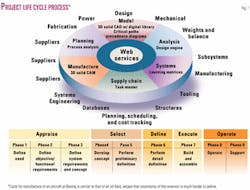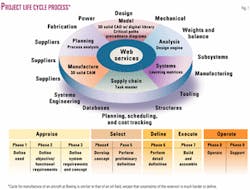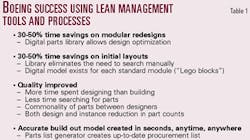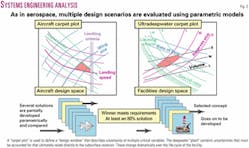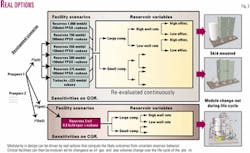Lean energy management is a methodology for efficient "manufacture" of oil and gas using software to enforce process rigor and discipline in order to dramatically cut costs and improve cycle times. It is an outgrowth of IDEF (integrated definition) modeling in aerospace manufacture processes and tools pioneered by the US Air Force in the 1970s.
IDEF is a methodology designed to model the end-to-end decisions, actions, and activities of an organization or system so that costs, performance, and cycle-times can be streamlined and optimized. IDEF methods have been adapted for wider use in automotive, aerospace, military, pharmaceuticals, and surprisingly, even in software development industries.
Lean energy management is still a new concept to the capital-intensive ultradeepwater oil and gas industry.
Background material
There are now 16 subsystems for IDEF that model function, information, and data flow and simulate processes, design, ontology, improvement, systems architecture, and the organization's networks. There is even an auditing IDEF.
As an example of the process, IDEF methods are used to model the functions of an enterprise, creating a graphical model, or roadmap, that shows what controls each important function, who performs it, what resources are required for carrying it out, what it produces, how much it costs, and what relationships it has to other functions of the organization.
Computer-based IDEF simulation of the enterprise has been found to be efficient at streamlining and modernizing both companies and governmental agencies. Today IDEF methods are maintained by the National Bureau of Standards, through Knowledge Based Systems (see http: //www.idef.com).
First Motorola, then famously GE, developed Six Sigma principals of lean management that can be traced to roots in IDEF modeling. At GE, Six Sigma has grown into more general "lean engineering" principles that are rigorously enforced throughout the organization.
Software is used to make the entire manufacturing system transparent and measurable, whether it's a light bulb, electric generator, or jet engine factory. GE requires process mapping of the "as is" condition of whatever system is to be improved, establishment of baseline metrics, identification of where the waste is occurring, planning of the improved "to be" process—all on the computer before change is authorized.
Then, software controls the implementation of the innovation plan, with constant reviews of performance metrics along the way. As good as its technologies are, GE does not differentiate through innovation itself so much as through execution of the systems integration processes required to manage innovation, whether it is new product or the manufacture of old, reliable light bulbs.
Another IDEF derivative is the lean automotive engineering model at Toyota. The Japanese derivatives Kaizen, Kaikaku, and Judoka can, in turn, be found at the base of process improvement methodologies of most other major innovation companies, both inside and outside the automotive industry today. The Toyota process management methodology is "bottom-up," consisting of "learning steps" of skill and knowledge acquisition, followed by "standards building" so that metrics of improvement can be mapped out. Only then does the "do action" start (sounds like Six Sigma).
In particular, significant improvements in lean engineering were made by Toyota in dealing with its subcontractors. Toyota realized that everything from just-in-time inventory delivery to total-quality-management, to adoption of new innovations, all depend as much on the performance of its outside suppliers as with itself.
At Toyota, corporate investments in new technologies include not only acquisition and venture investments, but also loans and sometimes outright gifts to suppliers to get them to buy into the Toyota lean management system. Why go to all that extra expense? Metrics and performance standards can then be tracked all day, every day throughout the "greater organizational system."
Perhaps the best developed evolution of the IDEF model is at Boeing Co. Boeing's project life cycle process (Fig. 1) has grown into a rigorous software system that links people, tasks, tools, materiel, and environmental impact of any newly planned project before building begins.
Routinely, more than half of the time for any given project is spent building the precedence diagrams, 3D process maps, integrating with outside suppliers, and designing the implementation plan, all on the computer. Once real activity is initiated, an "action tracker" is used to monitor inputs and outputs versus the schedule and to deliver metrics in real-time throughout the organization.
When the execution of a new airplane design begins, it is so well organized that it consistently cuts both costs and build-time in half for each successive generation of airframe.1 And, of course, it is paperless.
Ultradeepwater status
In the upstream oil and gas business, and particularly in its most capital-intensive offshore industry, lean manufacturing principles are not widely known, let alone are they used.
One-off construction of facilities is commonplace. We have found that the ratio of time devoted to physical fabrication, assembly, and installation versus digital design is 5:1 in the offshore industry, whereas in lean organizations in other industries that ratio can be as little as 1:5.
There are good reasons why lean processes and techniques have not yet spread to the offshore industry. It is a much more difficult manufacturing environment than that found in "lean industries." The manufacturing process in deepwater "plants" involves fuzzy resolution of the assets that are being produced.
Oil and gas are found in reservoirs miles underground, often with a mile of ocean on top of that. And perhaps the biggest differentiator is that, over time, the oil and gas reservoirs change shape and form, often in unpredictable ways.
Therefore in oil and gas, we will have to manage uncertainty over the life cycle of our production process in order to import the efficiencies of lean management principals. The cost breakdown of capex for a "typical" $1 billion ultradeepwater project involves 10% engineering design, 45% materials, 35% construction, and 10% transportation and installation. And these projects are often executed in hostile environments (both geographically and geopolitically).
It is a wonder of human achievement that the industry is as good at it as it is!
Ultradeepwater LEM
Lean energy management should be able to overcome these manufacturing uncertainties and cut capex costs and cycle times dramatically in the near future. Why?
There are abundant similarities between the automobile and aerospace experiences and those in the offshore industry. Both require large-scale systems integration of complex engineering projects. They involve multiple suppliers that are global, and there are many common suppliers to each owner. Improvements at the heart of lean energy management are obvious enablers to its early adoption (Table 1).
Lean management provides for earlier engagement of integrated product development teams (IPDT), improved access to new technologies, earlier rigor to "go/no-go" decisions, and an enhanced resource base and skill level of its managers and engineers.
In this time of the "graying-of-the-industry," a lean energy revolution would also open up an entirely new employment pool: aerospace and automotive engineers and managers. These lean thinkers would bring a fresh look to the elimination of customization, complexity, and interface conflicts.
Lean management would lower costs through more commonality in supply, compress cycle times, produce projects that are all on time and to budget, allow no "train wrecks," drive innovation matched to need, and improve first year operability to 90% or better—all these improvements have been driven by the lean aerospace model, and can be expected if they can be adapted successfully into a "lean energy " management model.
A survey of the offshore industry over the last 2 years finds that fully 35% of all deepwater projects are behind schedule, and that these were schedules that were not established at the outset using lean principles. The major reasons appear to be isolation of best practices methods and techniques from project to project, significant cost variations among similar projects, lack of lessons-learned carryover, very complex systems engineering, and poor construction and cost-control processes. Modularity in design is next to unheard-of, and first year operability is as low as 60%.
There are signs of the beginnings of awareness in lean management processes, however. Many offshore suppliers now use 3D solid models, the foundation upon which lean management is built. Yet they still produce paper drawings to pass on to their contractors.
The 3D solid model has been proven to improve design analysis, plant layout, bid quality and pricing accuracy, as well as marketing to the customer. However, these digital design tools are not then used for assembly simulation or clearance checks, for fabrication, or to guide installation. 3D solid models instead are only used early-on in most projects to conceptualize facilities (pre-proposal) and in the front-end engineering design phase. Little involvement by fabrication subcontractors exists in the design phase; this violates a primary principle of lean design and manufacturing management.
One obvious fix that lean energy management would bring to the offshore industry is that the current divisions between and among the owners, engineering designers, component manufacturers, and fabricators requires a lead systems integrator. An independent organization that is expert at lean management should guide the overall system design-build cycle, as is common in the aerospace and defense industries.
This conversion to lean energy management is required because of the large investments required to sustain oil and gas production over the foreseeable future. There will be at least 10 capex projects/year in the ultradeepwater that average $1 billion between now and 2010.
Reservoir uncertainty
Oil and gas production introduces uncertainty not present in the manufacture of cars or planes.
In addition to the well-known variations in price of the product, the reservoir often behaves in unpredictable and nonlinear ways. Size, rates of flow, volumes, and the mix of oil, gas, and water are often not predicted well by reservoir simulators until far into the life cycle of a field.
Compartments can appear and disappear because of fault zone breakdown and water coning. Pressures and reservoir drive mechanisms change significantly over time. Fluid mixes change because of water and gas breakthroughs and-or poorly designed injection programs. As a consequence, the economic performance of a deepwater field can vary substantially from year to year (Fig. 2).
Systems engineering analysis is a basic process in lean management2 used to account for this economic uncertainty. Notional "carpet plots" are used in the aerospace industry to develop versions of airframes that have differing capabilities. The oil and gas equivalent is the facilities design space, which is controlled by reservoir variability in size, rate of flow, volume, and fluid ratios.
The major addition to lean management required by the energy industry is that this "design space" changes over the life cycle of the asset. Unlike aerospace or automotive products, where different models of a common design are created to fill the design space, the oil and gas design space must be constantly re-evaluated over time because it moves. Its as if Boeing had to design a plane that changed from a 747 to a 737 to a 757 as it flew from city to city delivering differing load mixes.
Modularity is used in lean manufacture to account for this variability. For example, fluid separator skid units can be designed that can be changed-out as volumes of oil, gas, and water vary over time to maintain efficiency and manage costs.
In the example in Fig. 3, the fluid simulator for the reservoir was used to generate real options to evaluate the economic impact of a large water event predicted for late in the field's development. Separators could then be designed on skids for change out as necessary, rather than the usual industry practice of over-building the water processing capability of the original platform configuration.
In the lean energy case, several solutions are partially developed at the beginning of the design cycle. They are parametrically modeled so that design alternatives can be compared and modified as the design space changes. The winning modular design may only satisfy 80% of the requirements at maximum production rates so that flow must be choked off then, but real options show that long-term cost-effectiveness more than makes up for lost revenue later on in the life cycle.
Real options are the Wall Street way to quantify strategic investments and manage exposure to uncertainty when real assets are involved (e.g., see http://www.realoptions-software .com). Because real options address uncertainty over the life of any project, they should be applied from the initial investment conceptual stage to the final abandonment phase in the lean energy management system (Fig. 3).
Modularity can be built into the lean energy management system through software-enforced distribution of the 3D solid model of the integrated facility; topsides, subsea, reservoir, tiebacks, pipeline and all.
Electronic schematics, 3D routing and installation layouts, subsystems analyses, and virtual prototyping are all shared with relevant suppliers by the software so that version mismatches, modifications that are incompatible with each other, and module conflicts are identified in the 3D solid model long before any construction occurs. The virtual prototyping extends to fabrication so that modular change-out is built into the structures from day one.
Rework orders required because of interferences between subsystems or obstructions are eliminated. The assembly sequence itself, along with electronic work instructions for the fabrication yard, are tested, optimized, and distributed via web-based software tools. The owner provides the proper incentives so that all suppliers have compatible software.
Summary
For the ultradeepwater capex environment, the most relevant lean energy technologies and capabilities identified by economic modeling are large-scale systems integration (in particular, this seems to be missing from the present deepwater marketplace), along with integrated and compatible conceptual design, visualization, and collaboration software tools.
Extensive use of systems integration and project management skills and web-based software is also missing, along with the accompanying digital parts library, process tracking, metrics, and lean managerial skills.
The benefits from conversion to a lean energy paradigm for capex construction are clear from the economic model—costs and cycle-times cut in half!
In addition, the lean paradigm promises new design concepts that will make offshore structures ever cheaper and safer, with increased reliability and maintainability, increased up-time and utilization, and better real-time control of production (4D reservoir management).
Only with such a "lean energy revolution" will the ultradeepwater become truly affordable in the first place.
Next (conclusion): Challenges of the ultradeepwater frontier meet the industry's dearth of upstream research and development spending.
References
1. Esser, W., and Anderson, R.N., "The advanced digital enterprise in the ultradeepwater development," Offshore, October 2000.
2. Womack, J., and Jones, D., "Lean Thinking," Simon & Schuster, New York, 1996.
Bibliography
Anderson, R.N., et al., "Lean energy management required for economic ultradeepwater development," OGJ, Mar. 17, 2003, p. 47.
Anderson, R.N., and Esser, W., "Energy Company as Advanced Digital Enterprise," American Oil & Gas Reporter, January 2001.
Anderson, R.N., and Esser, W., "How to Operate Advanced Digital Enterprise," Offshore Tech., October 2000.
Anderson, R.N., et al, "Quantitative Tools link Portfolio Management with use of Technology, OGJ, Nov. 30, 1998, p. 48.
Anderson, R.N., "Oil Production in the 21st Century," Scientific American, Vol. 278, 1998, pp. 86-91.
Baldwin, C., and Clark, K., "Design Rules: The Power of Modularity," MIT Press, 2001.
Mathews, S.H., "Analyzing Engineering Projects Using Real Options—Intelligent Investments in the Face of Uncertainty in the Boeing Co.," (http: //www.decisioneering.com/stories/boeing_ro.html).
Oligney, R., Longbottom, J., and Kenderdine, M., "Ultra-deepwater R&D Program Needed," Hart's E&P, 2001.
Saputelli, L., Cherian, B., Grigoriadis, K., Nikolaou, M., Oudinot, C., Reddy, G., Economides, M., and Ehlig-Economides, C., "Integration of Computer-Aided High-Intensity Design with Reservoir Exploitation of Remote and Offshore Locations," SPE Paper #64621, 2000.
Smith, J., "Modeling and Valuing Real Options," (http://www.bus.utexas .edu/courses/MIS383N/Jim Smith pre- sentation 4-5-2002.pdf)
